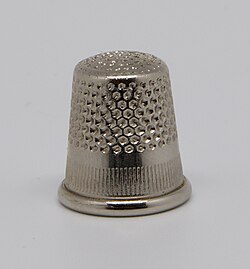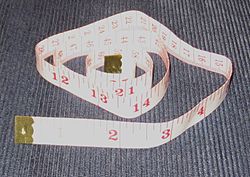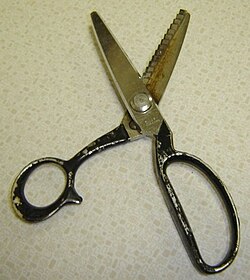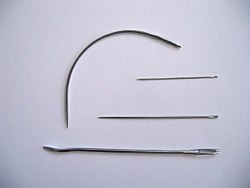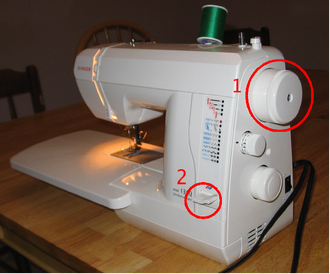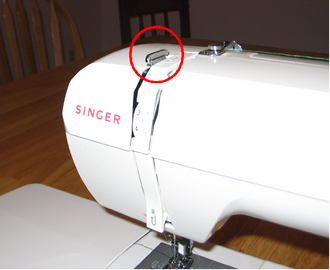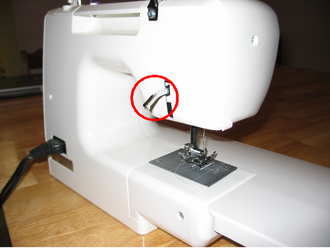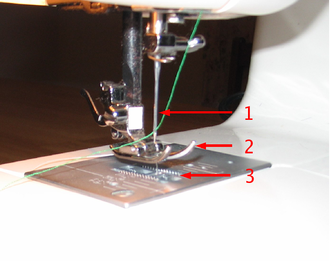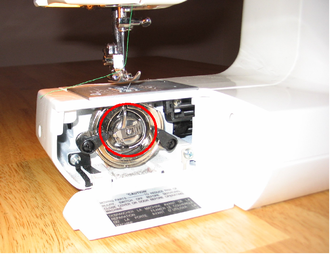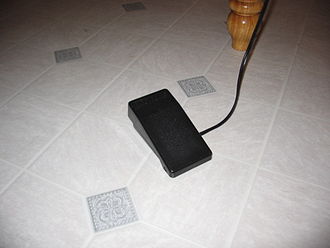Difference between revisions of "AY Honors/Basic Sewing/Answer Key"
| Line 12: | Line 12: | ||
===c. Scissors and shears=== | ===c. Scissors and shears=== | ||
| − | [[image:Schere_Gr_99.jpg|thumb| | + | [[image:Schere_Gr_99.jpg|thumb|100px|right|Scissors]] |
Scissors are used for cutting cloth. | Scissors are used for cutting cloth. | ||
<br style="clear:both"/> | <br style="clear:both"/> | ||
| + | |||
===d. Pinking shears=== | ===d. Pinking shears=== | ||
[[image:PinkingShears.jpg|thumb|200px|Pinking Shears]] | [[image:PinkingShears.jpg|thumb|200px|Pinking Shears]] | ||
Revision as of 03:49, 4 August 2006
1. Describe the proper use of the following:
a. Thimble
A thimble is a protective shield worn on the finger or thumb. It is used for pushing a needle through a piece of fabric in situations where the pressure applied to the needle would otherwise cause the needle to pierce the skin. A thimble is most usually made from metal, but can also be found made from leather, rubber, wood, glass or china.
b. Tape measure
A cloth tape measure is used for measuring a person for the purpose of sizing a garment. It is also used to measure cloth.
c. Scissors and shears
Scissors are used for cutting cloth.
d. Pinking shears
Pinking shears are scissors whose blades are sawtooth instead of straight. Pinking shears will leave a zigzag pattern instead of a straight edge.
Pinking shears are useful for cutting woven cloth. Cloth edges that are unfinished will easily fray, the weave becoming undone and threads pull out easily. The sawtooth pattern does not prevent the fraying but limits the length of the frayed thread and thus limits damage.
e. Needles of various sizes and types
Needles are used for piercing a fabric and passing a thread through it for the purpose of making a stitch. This can be done by hand or by machine. A hand needle has a hole in it (called the eye) near its back. A machine needle has its eye near the point.
2. Become acquainted with the sewing machine in your home or school. Identify:
a. Balance wheel
The balance wheel provides a method of manually moving the the needle up or down. It is used to raise the needle out of the cloth when s stitch is finished, or to raise the thread take-up to make it accessible when threading the machine.
b. Thread take-up
The thread take-up moves up and down with the needle, keeping the thread tight and drawing it from the spool as needed.
c. Presser foot
The presser foot holds the cloth in place while the needle runs thread through it. See the photo below for its location.
d. Presser foot lifter
The presser foot lifter raises and lowers the presser foot. Raise it when you need to place a piece of cloth under the needle (and under the presser foot).
e. Needle
The needle stitches the thread (green in the photo) through the cloth.
f. Feed dogs
The feed dogs are little tread-like pieces beneath the presser foot. As the sewing machine is operated, the feed dogs advance the cloth forward (or backwards if the backspace lever is activated). The presser foot holds the cloth against the feed dogs so that they can move the cloth along.
g. Bobbin
The bobbin supplies a second spool of thread. Between the bobbin and the needle, two pieces of thread are tied into a knot forming the stitch. The bobbin can be filled with thread by removing it from the position shown and placing it in a mechanism on the top of the sewing machine. It is usually filled with the same color thread as is thread through the needle. The bobbin's thread comes up from the bottom of the machine through a plate between the feed dogs.
h. Control
The control is a foot pedal that is similar to the gas pedal in a car. When it is fully depressed, the sewing machine operates at its maximum speed. When lightly depressed, the machine operates more slowly. When released, the sewing machine stops. Having a foot-operated control frees both hands for guiding the cloth through the machine.
i. Backspace lever
The backspace lever (shown in the photo with the balance wheel) reverses the direction that the feed dogs move the cloth. A stitch is often started an inch or so away from the edge of the coth with the backspace lever activated. When the stitch gets close to the edge of the cloth, the lever is released and the cloth moves forward through the machine. Stiches are also ended this way. Doing this provides a stronger seam and locks the stitch in place.
